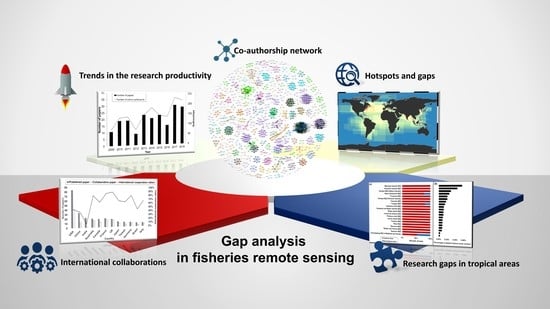Research Gap Analysis of Remote Sensing Application in Fisheries: Prospects for Achieving the Sustainable Development Goals
Abstract
:1. Introduction
2. Research Gaps in the Current Understanding of RS in Fisheries
3. Materials and Methods
3.1. Research Materials
3.2. Cooperative Network Connections
3.3. Comparison of the Cooperative Organizational Structures of The Main Research-Sponsoring Countries
3.4. Distribution of Hotspots and Gaps in Academic Research
4. Results
4.1. Progress in the International Application of RS in Fisheries
4.2. Network Pattern of the Application of RS in Fisheries
- United States (84);
- China (33);
- India (22);
- Australia (20);
- Canada (19);
- France (19);
- UK (18);
- Japan (12);
- Taiwan (11);
- Germany (10);
- Brazil (9);
- Italy (9).
4.3. Hotspots and the Gaps in Applying RS to Fisheries
5. Discussion
6. Conclusions
- the northeastern marine area of the United States;
- the high seas area of the North Atlantic Ocean;
- the surrounding sea areas of France, Spain and Portugal;
- the peripheral areas of the Indian Ocean;
- the East China Sea, Yellow Sea and Bohai Sea areas to the north of Taiwan.
Supplementary Materials
Author Contributions
Funding
Institutional Review Board Statement
Informed Consent Statement
Data Availability Statement
Conflicts of Interest
References
- FAO. The State of World Fisheries and Aquaculture 2018-Meeting the Sustainable Development Goals. Available online: http://www.fao.org/documents/card/en/c/I9540EN/ (accessed on 13 January 2021).
- United Nations World Population Prospects. 2019. Available online: https://population.un.org/wpp/ (accessed on 13 January 2021).
- Guo, H. Earth Observations in China and the World: History and Development in 50 Years. Bull. Chin. Acad. Sci. 2013, 27, 96–98. [Google Scholar]
- Pew Research Center World’s Population Is Projected to Nearly Stop Growing by the End of the Century. Available online: https://www.pewresearch.org/fact-tank/2019/06/17/worlds-population-is-projected-to-nearly-stop-growing-by-the-end-of-the-century/ (accessed on 13 January 2021).
- Our World in Data. Seafood Production. 2020. Available online: https://ourworldindata.org/seafood-production (accessed on 13 January 2021).
- Seafood Source News. A Fish Populations Are Thriving in Areas with Intense Management, Global Study Finds. Available online: https://www.seafoodsource.com/news/environment-sustainability/fish-populations-are-thriving-in-areas-with-intense-management-global-study-finds (accessed on 13 January 2021).
- United Nations. Transforming Our World: The 2030 Agenda for Sustainable Development. Available online: https://sdgs.un.org/sites/default/files/publications/21252030%20Agenda%20for%20Sustainable%20Development%20web.pdf (accessed on 13 January 2021).
- Messerli, P.; Murniningtyas, E. Global Sustainable Development Report 2019: The Future Is Now–Science for Achieving Sustainable Development; United Nations: New York, NY, USA, 2019. [Google Scholar]
- Allison, E.; Perry, A.; Badjeck, M.-C.; Adger, W.; Brown, K.; Conway, D.; Halls, A.; Pilling, G.; Reynolds, J.; Andrew, N.; et al. Vulnerability of National Economies to the Impacts of Climate Change on Fisheries. Fish Fish. 2009, 10, 173–196. [Google Scholar] [CrossRef] [Green Version]
- Dulvy, N.; Reynolds, J.D.; Pilling, G.M.; Pinnegar, J.K.; Scutt Phillips, J.; Allison, E.H.; Badjeck, M.-C. Fisheries management and governance challenges in a climate change. In The Economics of Adapting Fisheries to Climate Change; OECD Publishing: Paris, France, 2011; pp. 31–88. [Google Scholar]
- OECD iLibrary. Available online: https://www.oecd-ilibrary.org/agriculture-and-food/the-economics-of-adapting-fisheries-to-climate-change_9789264090415-en (accessed on 13 January 2021).
- Liao, C.P.; Huang, H.W. The cooperation strategies of fisheries between Taiwanese purse seiners and Pacific Island Countries. Mar. Policy 2016, 66, 67–74. [Google Scholar] [CrossRef]
- Pauly, D.; Zeller, D. Catch reconstructions reveal that global marine fisheries catches are higher than reported and declining. Nat. Commun. 2016, 7, 10244. [Google Scholar] [CrossRef] [PubMed]
- Ye, Y.; Gutierrez, N. Ending fishery overexploitation by expanding from local successes to globalized solutions. Nat. Ecol. Evol. 2017, 1. [Google Scholar] [CrossRef]
- González, R.; Gaspar, C.; Curtolo, L.; Sangiuliano, I.; Osovnikar, P.; Borsetta, N. Fishery and oceanographic monitoring system (foms): A new technological tool based on remote sensing, with application in ecosystem management of coastal fisheries in patagonia. Gayana 2003, 68. [Google Scholar] [CrossRef]
- Adams, W.M. The Future of Sustainability: Re-Thinking Environment and Development in the Twenty-First Century [Online]. Report of the IUCN Renowned Thinkers Meeting, 29–31 January 2006. Available online: https://portals.iucn.org/library/sites/library/files/documents/Rep-2006-002.pdf (accessed on 21 February 2021).
- Hilborn, R.; Fulton, E.; Green, B.; Hartmann, K.; Tracey, S.; Watson, R. When is a fishery sustainable? Can. J. Fish. Aquat. Sci. 2015, 72, 1433–1441. [Google Scholar] [CrossRef]
- Bao, J.; Gao, S.; Ge, J. Dynamic land use and its policy in response to environmental and social-economic changes in China: A case study of the Jiangsu coast (1750–2015). Land Use Policy 2019, 82, 169–180. [Google Scholar] [CrossRef]
- Peng, B. Application of Marine Remote Sensing Technology in the Development of Fishery Economy. J. Coast. Res. 2019, 94, 783–787. [Google Scholar] [CrossRef]
- Bulter, M.J.A.; Mouchot, M.C.; Barale, V.; LeBlanc, C. The Application of Remote Sensing Technology to Marine Fisheries: An Introductory Manual; FAO Fisheries Technical Paper, 295; FAO: Rome, Italy, 1988; Available online: http://www.fao.org/3/t0355e/T0355E00.HTM#toc (accessed on 13 January 2021).
- Saitoh, S.-I.; Mugo, I.N.; Radiarta, S.; Asaga, F.; Takahashi, T.; Hirawake, Y.; Ishikawa, T.; Awaji, T.; In, T.; Shima, S. Some operational uses of satellite remote sensing and marine GIS for sustainable fisheries and aquaculture. ICES J. Mar. Sci. 2011, 68, 687–695. [Google Scholar] [CrossRef] [Green Version]
- Pricope, N.; Mapes, K.; Woodward, K. Remote Sensing of Human–Environment Interactions in Global Change Research: A Review of Advances, Challenges and Future Directions. Remote Sens. 2019, 11, 2783. [Google Scholar] [CrossRef] [Green Version]
- Kim, M.; Yang, Y.; Kim, J. Sea Surface Temperature and High Water Temperature Occurrence Prediction Using a Long Short-Term Memory Model. Remote Sens. 2020, 12, 3654. [Google Scholar] [CrossRef]
- Wu, Y.L.; Lee, M.A.; Chen, L.C.; Chan, J.W.; Lan, K.W. Evaluating a Suitable Aquaculture Site Selection Model for Cobia (Rachycentron canadum) during Extreme Events in the Inner Bay of the Penghu Islands, Taiwan. Remote Sens. 2020, 12, 2689. [Google Scholar] [CrossRef]
- Santos, A.; Miguel, P. Fisheries oceanography using satellite and airborne remote sensing methods: A review. Fish. Res. 2000, 49, 1–20. [Google Scholar] [CrossRef]
- A Brief History of Remote Sensing. Available online: http://www.sarracenia.com/astronomy/remotesensing/primer0120.html (accessed on 13 January 2021).
- Chassot, E.; Bonhommeau, S.; Reygondeau, G.; Nieto, K.; Polovina, J.J.; Huret, M.; Dulvy, N.K.; Demarcq, H. Satellite remote sensing for an ecosystem approach to fisheries management. ICES J. Mar. Sci. 2011, 68, 651–666. [Google Scholar] [CrossRef] [Green Version]
- Klemas, V.V. Fisheries Applications of Remote Sensing: An Overview. Fish. Res. 2013, 148, 124–136. [Google Scholar] [CrossRef]
- Zhu, L.J.; Suomalainen, J.; Liu, J.; Hyyppä, J.; Kaartinen, H.; Haggren, H. A review: Remote sensing sensors. In Multi-Purposeful Application of Geospatial Data; Rustamov, R.B., Hasanova, S., Zeynalova, M.H., Eds.; Intechopen: London, UK, 2018; pp. 19–42. [Google Scholar]
- Liang, S.; Wang, D.; He, T.; Yu, Y. Remote sensing of earth’s energy budget: Synthesis and review. Int. J. Digit. Earth 2019, 12, 737–780. [Google Scholar] [CrossRef] [Green Version]
- Sakti, A.D.; Fauzi, A.I.; Wilwatikta, F.N.; Rajagukguk, Y.S.; Sudhana, S.A.; Yayusman, L.F.; Syahid, L.N.; Sritarapipat, T.; Principe, J.A.; Trang, N.T.Q.; et al. Multi-Source Remote Sensing Data Product Analysis: Investigating Anthropogenic and Naturogenic Impacts on Mangroves in Southeast Asia. Remote Sens. 2020, 12, 2720. [Google Scholar] [CrossRef]
- Su, N.J.; Chang, C.H.; Hu, Y.T.; Chiang, W.C.; Tseng, C.T. Modeling the Spatial Distribution of Swordfish (Xiphias gladius) Using Fishery and Remote Sensing Data: Approach and Resolution. Remote Sens. 2020, 12, 947. [Google Scholar] [CrossRef] [Green Version]
- Vayghan, A.H.; Lee, M.A.; Weng, J.S.; Mondal, S.; Lin, C.T.; Wang, Y.C. Multisatellite-Based Feeding Habitat Suitability Modeling of Albacore Tuna in the Southern Atlantic Ocean. Remote Sens. 2020, 12, 2515. [Google Scholar] [CrossRef]
- Tang, D.L.; Levy, G. Introduction. In Remote Sensing of the Changing Oceans; Tang, D.L., Gower, J., Levy, G., Katsaros, K., Heron, M., Singh, R., Eds.; Springer: Berlin/Heidelberg, Germany, 2011; pp. 1–3. [Google Scholar]
- Dechesne, C.; Lefevre, S.; Vadaine, R.; Hajduch, G.; Fablet, R. Ship Identification and Characterization in Sentinel-1 SAR Images with Multi-Task Deep Learning. Remote Sens. 2019, 11, 2997. [Google Scholar] [CrossRef] [Green Version]
- Mugo, R.; Saitoh, S.I. Ensemble Modelling of Skipjack Tuna (Katsuwonus pelamis) Habitats in the Western North Pacific Using Satellite Remotely Sensed Data; a Comparative Analysis Using Machine-Learning Models. Remote Sens. 2020, 12, 2591. [Google Scholar] [CrossRef]
- Eugenio, F.; Marcello, J.; Martin, J. Multiplatform Earth Observation Systems for Monitoring Water Quality in Vulnerable Inland Ecosystems: Maspalomas Water Lagoon. Remote Sens. 2020, 12, 284. [Google Scholar] [CrossRef] [Green Version]
- Liu, Y.M.; Lu, C.; Yang, X.M.; Wang, Z.H.; Liu, B. Fine-Scale Coastal Storm Surge Disaster Vulnerability and Risk Assessment Model: A Case Study of Laizhou Bay, China. Remote Sens. 2020, 12, 1301. [Google Scholar] [CrossRef] [Green Version]
- Paul, C.K.; Mascarenhas, A.C. Remote sensing in development. Sci. New Ser. 1981, 214, 139–145. [Google Scholar] [CrossRef]
- Brewington, L.; Frizzelle, B.; Walsh, S.; Mena, C.; Sampedro, C. Remote Sensing of the Marine Environment: Challenges and Opportunities in the Galapagos Islands of Ecuador. In The Galapagos Marine Reserve: A Dynamic Social-Ecological System; Denkinger, J., Vinueza, L., Eds.; Springer: New York, NY, USA, 2014; Chapter 6; pp. 109–136. [Google Scholar]
- Nishida, T.; Itoh, K. GIS in Fisheries Resources Research: Current Situation and Prospects. In Proceedings of the 6th JIRCAS International Symposium: GIS Application for Agro-Environmental Issues in Developing Regions, Tsukuba, Japan, 7–8 September 1999; pp. 39–57. [Google Scholar]
- Boivin, T.; Coats, D.; Werle, D.; Baird, J. Remote Sensing Applications for Information Generation and Monitoring of Large River Fisheries. In Proceedings of the Second International Symposium on the Management of Large Rivers for Fisheries: Sustaining Livelihoods and Biodiversity in the New Millennium, Mekong River Commission Secretariat, Phnom Penh, Cambodia, 11–14 February 2003. [Google Scholar]
- De Graaf, G.; Marttin, F.; Aguilar-Manjarrez, J.; Jenness, J. Geographic Information Systems in Fisheries Management and Planning Technical manual; FAO Fisheries Technical Paper 449; FAO: Rome, Italy, 2003. [Google Scholar]
- De Silva, S.S.; Soto, D. Climate Change and Aquaculture: Potential Impacts, Adaptation and Mitigation. Climate Change Implications for Fisheries and Aquaculture: Overview of Current Scientific Knowledge; FAO Fisheries and Aquaculture Technical Paper; FAO: Rome, Italy, 2009; Volume 530, pp. 151–212. [Google Scholar]
- Marine Geographic Database. Available online: https://www.marineregions.org/ (accessed on 11 January 2021).
- Rhoades, S.A. The herfindahl-hirschman index. Fed. Res. Bull. 1993, 79, 188–189. [Google Scholar]
- Luukkonen, T.; Persson, O.; Sivertsen, G. Understanding Patterns of International Scientific Collaboration. Science. Technol. Hum. Values 1992, 17, 101–126. [Google Scholar] [CrossRef] [Green Version]
- Lam, V.W.Y.; Allison, E.H.; Bell, J.D.; Blythe, J.; Cheung, W.W.L.; Frölicher, T.L.; Gasalla, M.A.; Sumaila, U.R. Climate change, tropical fisheries and prospects for sustainable development. Nat. Rev. Earth Environ. 2020, 1, 440–454. [Google Scholar] [CrossRef]
- United Nations Least Developed Countries (LDCS). Available online: https://www.un.org/development/desa/dpad/least-developed-country-category/ldcs-at-a-glance.html (accessed on 13 January 2021).
- Mitra, M.; Chaudhuri, B.B. Information Retrieval from Documents: A Survey. Inf. Retr. J. 2000, 2, 141–163. [Google Scholar] [CrossRef]
- Grinäv, A. The Disadvantages of Using Scientometric Indicators in the Digital Age the Disadvantages of Using Scientometric Indicators in the Digital Age. IOP Conf. Ser. Mater. Sci. Eng. 2020, 970. [Google Scholar] [CrossRef]
- Gentles, S.J.; Charles, C.; Ploeg, J.; McKibbon, K.A. Sampling in qualitative research: Insights from an overview of the methods literature. Qual. Rep. 2015, 20, 1772–1789. [Google Scholar]
- Platt, T.; Sathyendranath, S. Ecological indicators for the pelagic zone of the ocean from remote sensing. Remote Sens Environ. 2008, 112, 3426–3436. [Google Scholar] [CrossRef]
- Stuart, V.; Platt, T.; Sathyendranath, S. The future of fisheries science in management: A remote-sensing perspective. ICES J. Mar. Sci. 2011, 68, 644–650. [Google Scholar] [CrossRef] [Green Version]
- Pierre, M.; Rouyer, T.; Bonhommeau, S.; Fromentin, J.M. Assessing causal links in fish stock-recruitment relationships. ICES J. Mar. Sci. 2018, 75, 903–911. [Google Scholar] [CrossRef]
- Forrest, R.E.; Walters, C.J. Estimating thresholds to optimal harvest rate for long-lived, low-fecundity sharks accounting for selectivity and density dependence in recruitment. Can. J. Fish. Aquat. Sci. 2009, 66, 2062–2080. [Google Scholar] [CrossRef]
- Juan-Jorda, M.J.; Mosqueira, I.; Freire, J.; Dulvy, N.K. Life in 3-D: Life history strategies in tunas, mackerels and bonitos. Rev. Fish. Biol. Fish. 2013, 23, 135–155. [Google Scholar] [CrossRef]
- Newman, S.J.; Williams, A.J.; Wakefield, C.B.; Nicol, S.J.; Taylor, B.M.; O’Malley, J.M. Review of the life history characteristics, ecology and fisheries for deep-water tropical demersal fish in the Indo-Pacific region. Rev. Fish. Biol. Fish. 2016, 26, 537–562. [Google Scholar] [CrossRef]
- Nikolic, N.; Morandeau, G.; Hoarau, L.; West, W.; Arrizabalaga, H.; Hoyle, S.; NICOL, S.; Bourjea, J.; Puech, A.; Farley, J.H.; et al. Review of albacore tuna, Thunnus alalunga, biology, fisheries and management. Rev. Fish Biol. Fish. 2017, 27, 775–810. [Google Scholar] [CrossRef]
- Lee, M.A.; Wang, Y.C.; Chen, Y.K.; Chen, W.Y.; Wu, L.J.; Liu, D.C.; Wu, J.L.; Teng, S.Y. Summer assemblages of ichthyoplankton in the waters of the East China Sea shelf and around Taiwan in 2007. J. Mar. Sci. Technol. Taiwan 2013, 21, 41–51. [Google Scholar] [CrossRef]
- Cresson, R. Deep Learning for Remote Sensing Images with Open Source Software; CRC Press: London, UK, 2020. [Google Scholar]
- Jacobs, Z.L.; Jebri, F.; Srokosz, M.; Raitsos, D.E.; Painter, S.C.; Nencioli, F.; Osuka, K.; Samoilys, M.; Sauer, W.; Roberts, M.; et al. A Major Ecosystem Shift in Coastal East African Waters during the 1997/98 Super El Nino as Detected Using Remote Sensing Data. Remote Sens. 2020, 12, 3127. [Google Scholar] [CrossRef]
- Osayande, O.; Ukpebor, C. Grey Literature Acquisition and Management: Challenges in Academic Libraries in Africa. Libr. Philos. Pract. 2012. Available online: https://digitalcommons.unl.edu/libphilprac/700 (accessed on 20 February 2021).
- Nussbaumer-Streit, B.; Klerings, I.; Dobrescu, A.I.; Persad, E.; Stevens, A.; Garritty, C.; Kamel, C.; Affengruber, L.; King, V.; Gartlehner, G. Excluding non-English publications from evidence-syntheses did not change conclusions: A meta-epidemiological study. J. Clin. Epidemiol. 2019, 118. [Google Scholar] [CrossRef]
- Schroter, S.; Tite, L.; Smith, R. Perceptions of open access publishing: Interviews with journal authors. BMJ 2005, 330, 756. [Google Scholar] [CrossRef] [Green Version]
- Warlick, S.E.; Vaughan, K. Factors influencing publication choice: Why faculty choose open access. Biomed. Digit. Libr. 2007, 4, 1–12. [Google Scholar] [CrossRef] [PubMed] [Green Version]
- Zhu, X.L.; Cai, F.Y.; Tian, J.Q.; Williams, T.K.A. Spatiotemporal Fusion of Multisource Remote Sensing Data: Literature Survey, Taxonomy, Principles, Applications, and Future Directions. Remote Sens. 2018, 10, 23. [Google Scholar] [CrossRef] [Green Version]
- Syed, S.; Aodha, L.; Scougal, C.; Spruit, M. Mapping the global network of fisheries science collaboration. Fish Fish. 2019, 20. [Google Scholar] [CrossRef] [Green Version]
- Portner, H.O.; Peck, M.A. Climate change effects on fishes and fisheries: Towards a cause-and-effect understanding. J. Fish. Biol. 2010, 77, 1745–1779. [Google Scholar] [CrossRef]
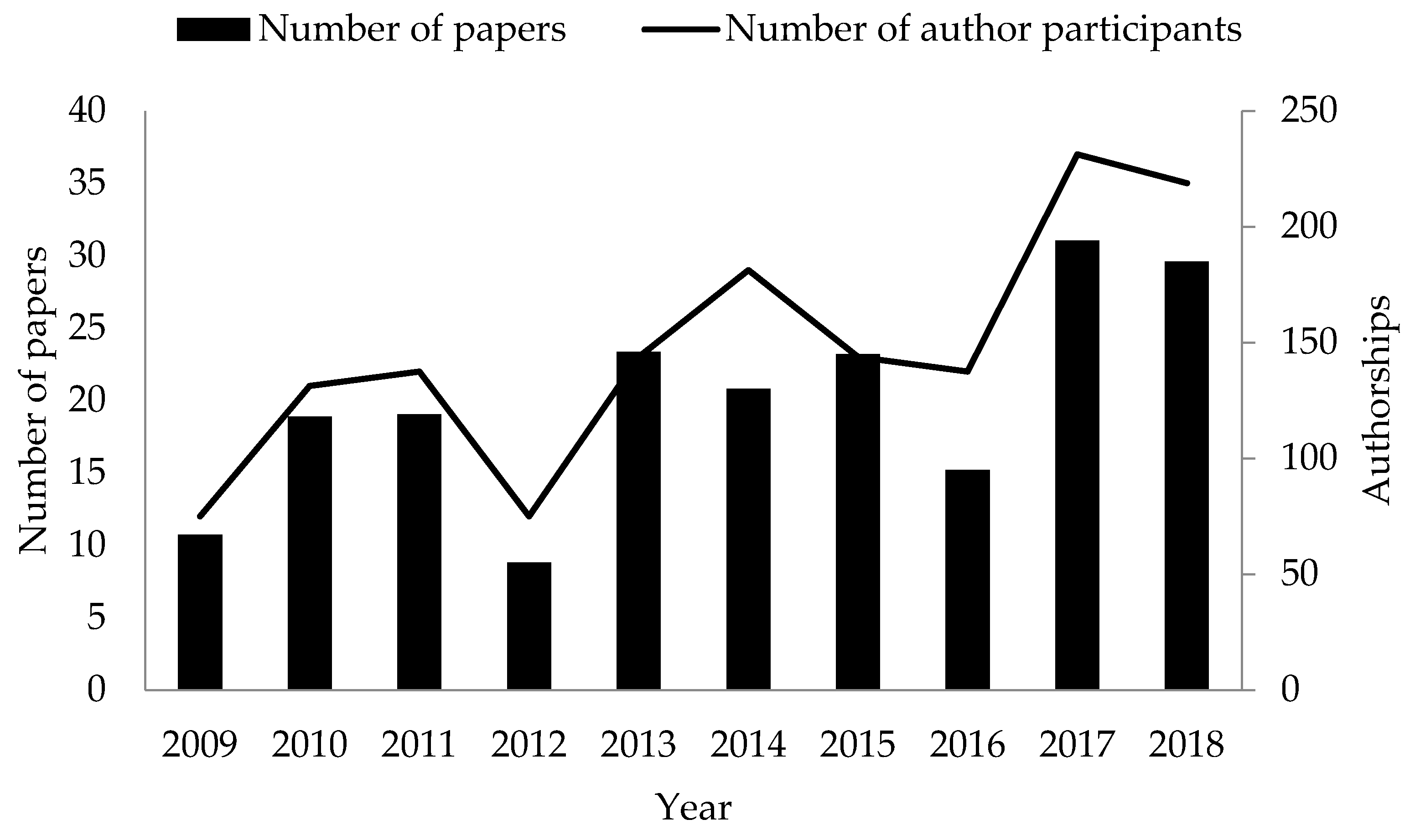
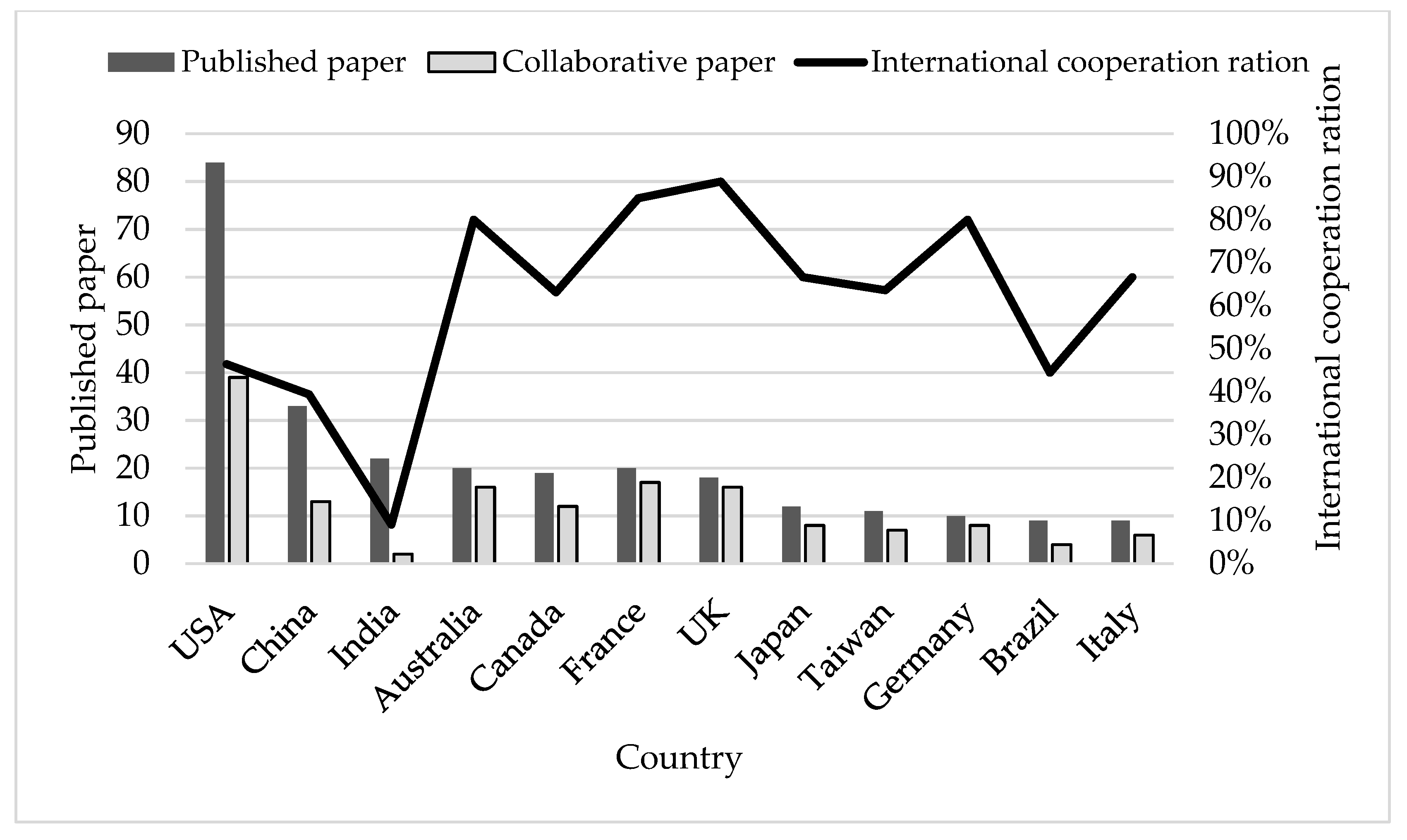
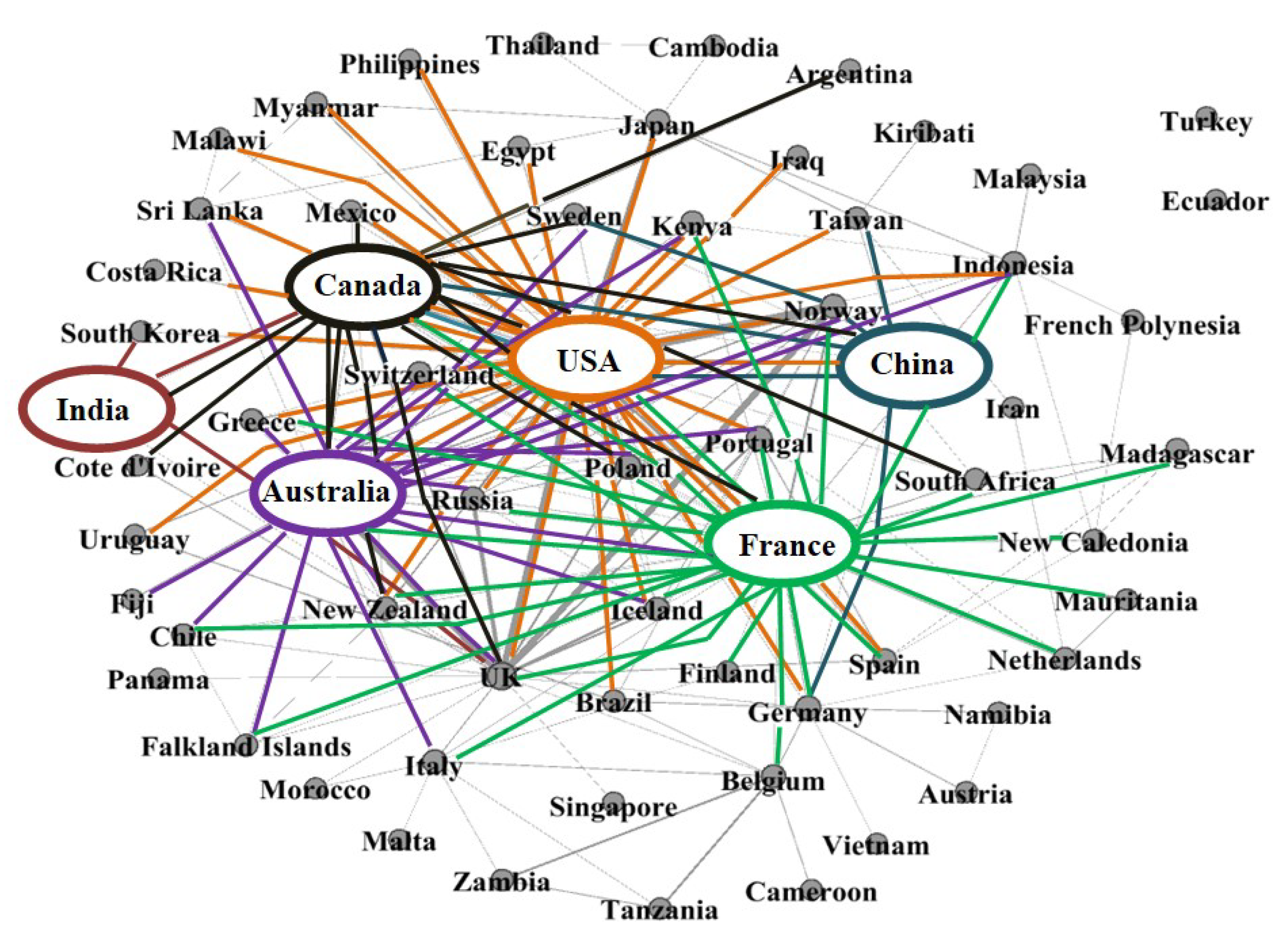
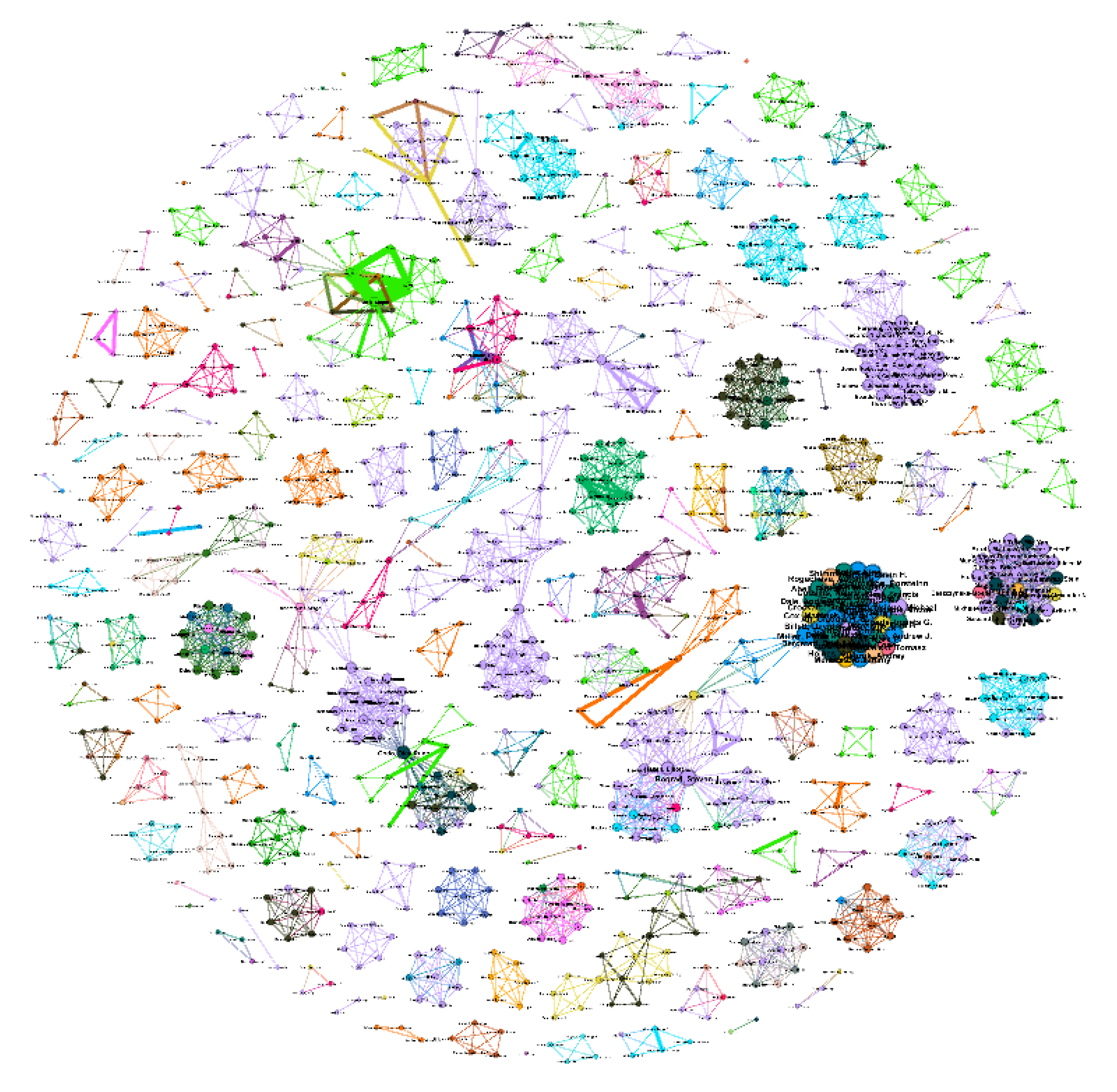

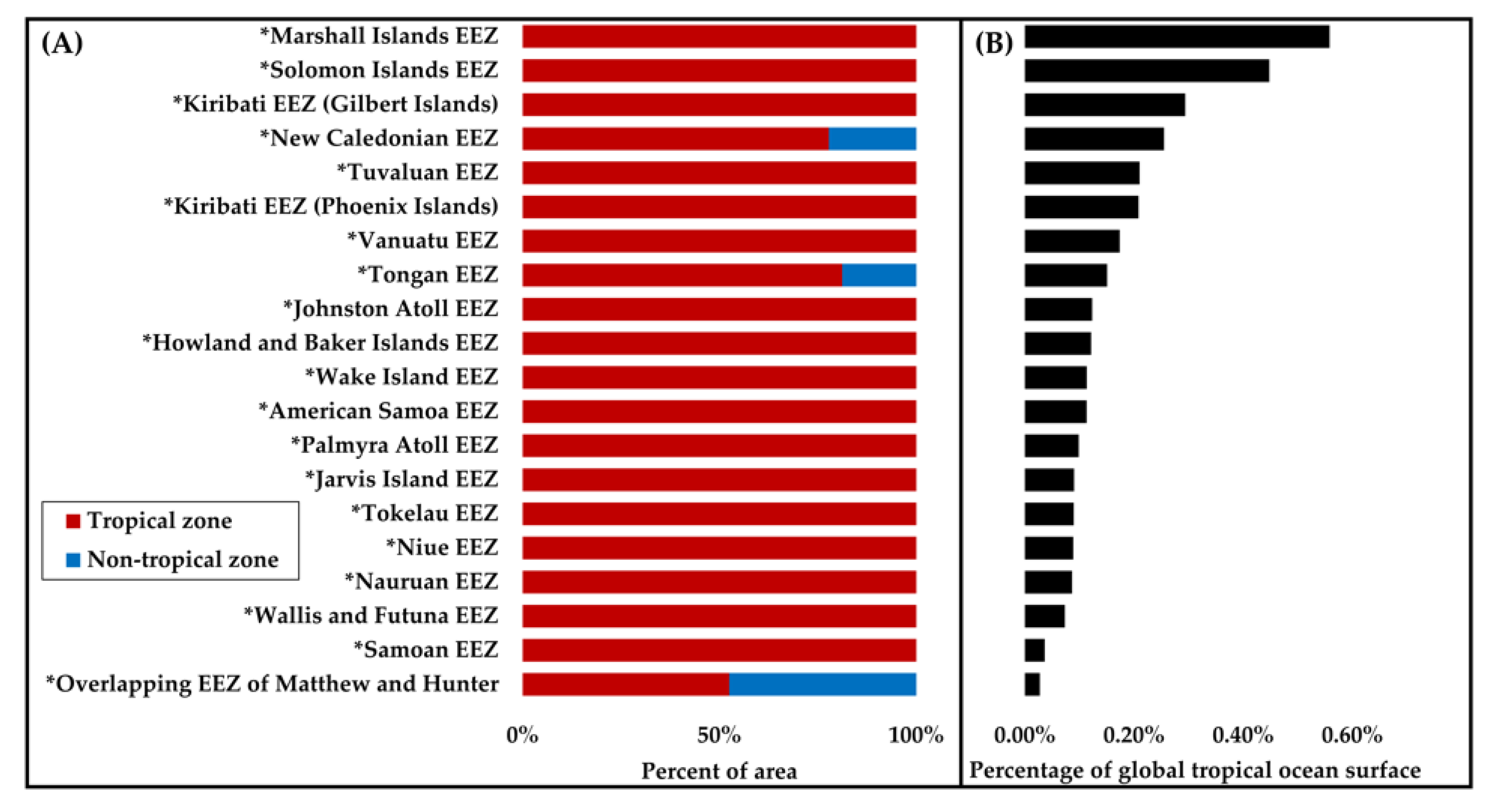
| Country | Total Number of Authorships during the Study Period (2009–2018) | 1st Five-Year Period (2009–2013) | 2nd Five-Year Period (2014–2018) | Growth Rate |
|---|---|---|---|---|
| USA | 366 | 172 | 194 | 13% |
| China | 130 | 30 | 100 | 233% |
| Others * | 115 | 43 | 72 | 67% |
| India | 79 | 25 | 54 | 116% |
| UK | 61 | 42 | 19 | −55% |
| France | 51 | 27 | 24 | −11% |
| Italy | 51 | 23 | 28 | 22% |
| Japan | 45 | 21 | 24 | 14% |
| Australia | 38 | 8 | 30 | 275% |
| Taiwan | 37 | 13 | 24 | 85% |
| Canada | 35 | 16 | 19 | 19% |
| Brazil | 32 | 15 | 17 | 13% |
| Germany | 31 | 12 | 19 | 58% |
| Spain | 28 | 3 | 25 | 733% |
| Belgium | 22 | 18 | 4 | −78% |
| Argentina | 21 | 4 | 17 | 325% |
| Mexico | 17 | 3 | 14 | 367% |
| Norway | 16 | 9 | 7 | −22% |
| South Africa | 15 | 3 | 12 | 300% |
| Philippines | 14 | 0 | 14 | - |
| South Korea | 14 | 9 | 5 | −44% |
| Indonesia | 13 | 0 | 13 | - |
| Turkey | 13 | 7 | 6 | −14% |
| Portugal | 10 | 2 | 8 | 300% |
| Rank | Country | International | Domestic | Total |
|---|---|---|---|---|
| 1 | USA | 39 | 45 | 84 |
| 2 | China | 13 | 20 | 33 |
| 3 | India | 2 | 20 | 22 |
| 4 | Australia | 16 | 4 | 20 |
| 4 | France | 17 | 3 | 20 |
| 5 | Canada | 12 | 7 | 19 |
| 6 | UK | 16 | 2 | 18 |
| 7 | Japan | 8 | 4 | 12 |
| 8 | Taiwan | 7 | 4 | 11 |
| 9 | Germany | 8 | 2 | 10 |
| 10 | Brazil | 4 | 5 | 9 |
| 10 | Italy | 6 | 3 | 9 |
| 11 | Spain | 5 | 3 | 8 |
| 12 | South Africa | 6 | 1 | 7 |
| 13 | Belgium and Norway | 6 | 0 | 6 |
| 14 | Argentina | 1 | 4 | 5 |
| 14 | Mexico | 2 | 3 | 5 |
| 15 | Indonesia | 4 | 0 | 4 |
| 15 | Kenya, Malaysia and the Netherlands | 3 | 1 | 4 |
| 1 5 | New Caledonia, New Zealand, Poland, Portugal and Russia | 4 | 0 | 4 |
| 16 | South Korea | 2 | 1 | 3 |
| 16 | Sri Lanka | 3 | 0 | 3 |
| 17 | Cambodia, Fiji, Iran, Madagascar and Sweden | 2 | 0 | 2 |
| 17 | Finland, Singapore and Thailand | 1 | 1 | 2 |
| 18 | Austria, Cameroon, Chile, Costa Rica, Cote d’Ivoire, Egypt, Falkland Islands, French Polynesia, Greece, Iceland, Iraq, Kiribati, Malawi, Malta, Mauritania, Morocco, Myanmar, Namibia, Panama, Philippines, Switzerland, Tanzania, Uruguay, Vietnam and Zambia | 1 | 0 | 1 |
| 18 | Turkey and Ecuador | 0 | 1 | 1 |
| Total | 250 | 139 | 389 |
| Rank | Authors | Title | Total Citation | Publication Year | Level of Collaboration |
|---|---|---|---|---|---|
| 1 | Anderson, D. M. | Approaches to monitoring, control and management of harmful algal blooms (HABs) | 207 | 2009 | Single author |
| 2 | Lavik, G.; Stührmann, T.; Brüchert, V.; Van der Plas, A.; Mohrholz, V.; Lam, P.; Mussmann, M.; Fuchs, B. M.; Amann, R.; Lass, U.; and Kuypers, M. M. | Detoxification of sulphidic African shelf waters by blooming chemolithotrophs | 181 | 2009 | International |
| 3 | Richards, D. R.; and Friess, D. A. | Rates and drivers of mangrove deforestation in Southeast Asia, 2000–2012 | 171 | 2016 | Domestic |
| 4 | Zhu, C.; Zhou, H.; Wang, R.; and Guo, J. | A Novel Hierarchical Method of Ship Detection from Spaceborne Optical Image Based on Shape and Texture Features | 165 | 2010 | Domestic |
| 5 | Hamilton, S. E.; and Casey, D. | Creation of a high spatio-temporal resolution global database of continuous mangrove forest cover for the 21st century (CGMFC-21) | 140 | 2016 | Domestic |
| 6 | Heumann, B. W. | Satellite remote sensing of mangrove forests: Recent advances and future opportunities | 136 | 2011 | Domestic |
| 7 | Murphy, H. M.; and Jenkins, G. P. | Observational methods used in marine spatial monitoring of fishes and associated habitats: a review | 123 | 2010 | Domestic |
| 8 | Pittman, S. J.; and Brown, K. A. | Multi-Scale Approach for Predicting Fish Species Distributions across Coral Reef Seascapes | 117 | 2011 | International |
| 9 | Li, J.; Wang, X.; Wang, X.; Ma, W.; and Zhang, H. | Remote sensing evaluation of urban heat island and its spatial pattern of the Shanghai metropolitan area, China | 114 | 2009 | Domestic |
| 10 | Corbane, C.; Najman, L.; Pecoul, E.; Demagistri, L.; and Petit, M | A complete processing chain for ship detection using optical satellite imagery | 85 | 2010 | International |
Publisher’s Note: MDPI stays neutral with regard to jurisdictional claims in published maps and institutional affiliations. |
© 2021 by the authors. Licensee MDPI, Basel, Switzerland. This article is an open access article distributed under the terms and conditions of the Creative Commons Attribution (CC BY) license (http://creativecommons.org/licenses/by/4.0/).
Share and Cite
Yen, K.-W.; Chen, C.-H. Research Gap Analysis of Remote Sensing Application in Fisheries: Prospects for Achieving the Sustainable Development Goals. Remote Sens. 2021, 13, 1013. https://doi.org/10.3390/rs13051013
Yen K-W, Chen C-H. Research Gap Analysis of Remote Sensing Application in Fisheries: Prospects for Achieving the Sustainable Development Goals. Remote Sensing. 2021; 13(5):1013. https://doi.org/10.3390/rs13051013
Chicago/Turabian StyleYen, Kuo-Wei, and Chia-Hsiang Chen. 2021. "Research Gap Analysis of Remote Sensing Application in Fisheries: Prospects for Achieving the Sustainable Development Goals" Remote Sensing 13, no. 5: 1013. https://doi.org/10.3390/rs13051013





